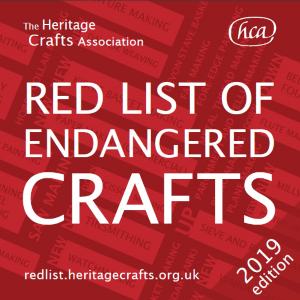 New research by the Heritage Crafts Association (HCA) has unearthed dozens more traditional craft skills on the verge of extinction in the UK, in the first major update of its pioneering project, the Red List of Endangered Crafts.
New research by the Heritage Crafts Association (HCA) has unearthed dozens more traditional craft skills on the verge of extinction in the UK, in the first major update of its pioneering project, the Red List of Endangered Crafts.
The Heritage Crafts Association writes:
Sixteen new crafts have been added to the ‘critically endangered’ category of the Red List, meaning that they are at serious risk of dying out in the next generation, including withy crab pot making, millwrighting and commercial handmade paper making. They join 20 other critically endangered crafts, including five (bell founding, flute making, scissor making, tin smithing and watch making) that have been reclassified as being at a higher level of risk than when the research was first published in 2017.
Critically endangered crafts include those with very few practitioners, few (if any) trainees and a lack of viable training routes by which the skills can be passed on. Often they serve very niche markets, and craftspeople cannot afford to step away from production to train their successors for fear those markets will disappear.
It’s not all bad news, however, as the craft of sieve and riddle making, which was listed as extinct in 2017, has now been revived by two new makers devoted to bringing it back, both of whom are now beginning commercial production. In addition, the organisation behind the research, the Heritage Crafts Association, has, with funding from The Dulverton Trust, employed an Endangered Crafts Officer to look for practical ways to safeguard these crafts skills, and has set up an Endangered Crafts Fund to provide the means to do so.
Daniel Carpenter, who led the research on behalf of the Heritage Crafts Association, said: ‘The Red List of Endangered Crafts is vital in drawing our attention to parts of our shared cultural heritage we are at greatest risk of losing. What we as a society decide to do with that knowledge is up to us, but at the Heritage Crafts Association we believe that the country’s skills and practices can be just as valuable as its historic artefacts and monuments… perhaps even more so as they may offer opportunities for future generations to create their own sustainable and fulfilling livelihoods in ways we cannot yet imagine. If we allow these crafts to disappear then we seriously diminish these opportunities.’
Whilst the UK has been a world-leader in the preservation of tangible heritage (museum collections, buildings and monuments), it has fallen behind the rest of the world when it comes to the safeguarding of intangible heritage (knowledge, skills and practices). It is among only 15 of 193 UNESCO members that has not yet ratified the 2003 Convention on the Safeguarding of Intangible Heritage, and government responsibility for heritage crafts falls in the gap between agencies set up to support arts and heritage.
Julie Crawshaw, Director of the Heritage Crafts Association, said:
‘In an age of hyper-digitisation these skills can offer a viable alternative workplace and a lifestyle that can bring a sense of accomplishment and increased wellbeing. As examples of tacit knowledge that cannot easily be passed on in written form; they survive only through practice and the transmission of skill from one person to another. The Heritage Crafts Association, which is celebrating its tenth year in 2019, is dedicated to safeguarding heritage crafts skills for the benefit of everyone.’

